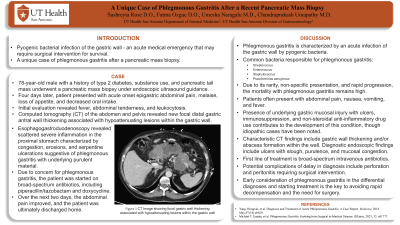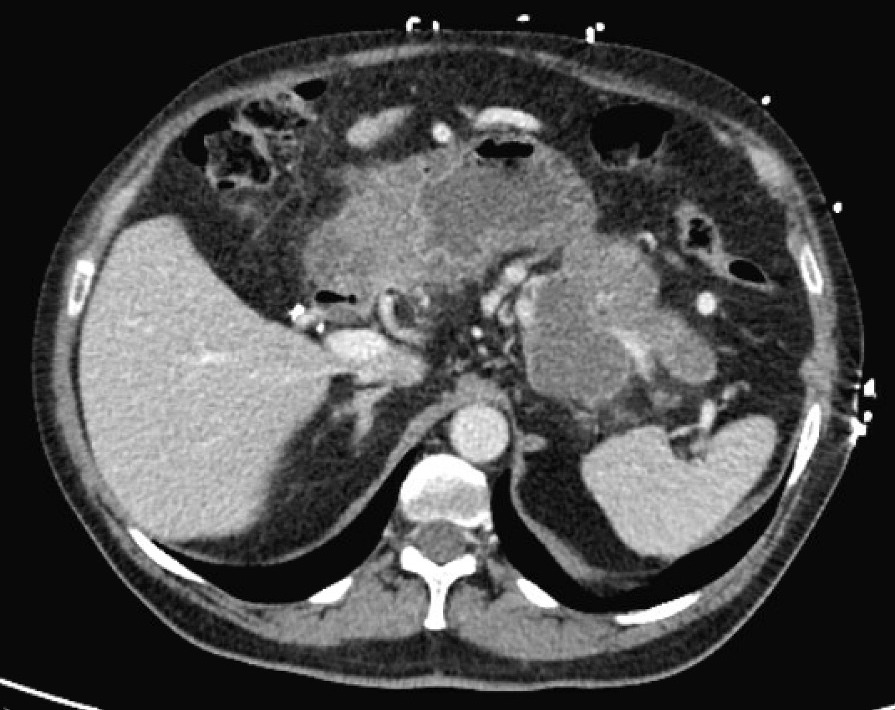Tuesday Poster Session
Category: Stomach
P4194 - A Unique Case of Phlegmonous Gastritis After a Recent Pancreatic Mass Biopsy
Tuesday, October 24, 2023
10:30 AM - 4:00 PM PT
Location: Exhibit Hall

Has Audio

Sushreyta Rose, DO
University of Texas Health Science Center at San Antonio
San Antonio, TX
Presenting Author(s)
Sushreyta Rose, DO1, Fatma Ozguc, DO2, Umesha Boregowda, MD3, Chandraprakash Umapathy, MD, MS1
1University of Texas Health Science Center at San Antonio, San Antonio, TX; 2UTHSCSA, San Antonio, TX; 3UT Health San Antonio, San Antonio, TX
Introduction: Pyogenic bacterial infection of the gastric wall is an acute medical emergency that may require surgical intervention to achieve the best outcome. We are presenting a unique case of phlegmonous gastritis after a pancreatic mass biopsy.
Case Description/Methods: A 78-year-old male with a history of type 2 diabetes, substance use, and pancreatic tail mass underwent a pancreatic mass biopsy under endoscopic ultrasound guidance. Four days later, the patient presented with acute onset epigastric abdominal pain, malaise, loss of appetite, and decreased oral intake. Initial evaluation revealed fever, abdominal tenderness, and leukocytosis. Furthermore, computed tomography (CT) of the abdomen and pelvis revealed new focal distal gastric antral wall thickening associated with hypoattenuating lesions within the gastric wall. Esophagogastroduodenoscopy revealed scattered severe inflammation in the proximal stomach characterized by congestion, erosions, and serpentine ulcerations suggestive of phlegmonous gastritis with underlying purulent material. Due to concern for phlegmonous gastritis, the patient was started on broad-spectrum antibiotics, including piperacillin/tazobactam and doxycycline. Over the next two days, the abdominal pain improved, and the patient was ultimately discharged home.
Discussion: Phlegmonous gastritis is characterized by an acute infection of the gastric wall by pyogenic bacteria. Common bacteria responsible for phlegmonous gastritis are Streptococcus, Enterococcus, Staphylococcus, and Pseudomonas aeruginosa. Due to its rarity, non-specific presentation, and rapid progression, the mortality with phlegmonous gastritis remains high. Patients often present with abdominal pain, nausea, vomiting, and fever. The presence of underlying gastric mucosal injury with ulcers, immunosuppression, and non-steroidal anti-inflammatory drug use contributes to the development of this condition, though idiopathic cases have been noted. Characteristic CT findings include gastric wall thickening and/or abscess formation within the wall. Diagnostic endoscopic findings include ulcers with slough, purulence, and mucosal congestion. The first line of treatment for phlegmonous gastritis is broad-spectrum intravenous antibiotics. Potential complications of delay in diagnosis include perforation and peritonitis requiring surgical intervention.
Early consideration of phlegmonous gastritis in the differential diagnoses and starting treatment is the key to avoiding rapid decompensation and the need for surgery.

Disclosures:
Sushreyta Rose, DO1, Fatma Ozguc, DO2, Umesha Boregowda, MD3, Chandraprakash Umapathy, MD, MS1. P4194 - A Unique Case of Phlegmonous Gastritis After a Recent Pancreatic Mass Biopsy, ACG 2023 Annual Scientific Meeting Abstracts. Vancouver, BC, Canada: American College of Gastroenterology.
1University of Texas Health Science Center at San Antonio, San Antonio, TX; 2UTHSCSA, San Antonio, TX; 3UT Health San Antonio, San Antonio, TX
Introduction: Pyogenic bacterial infection of the gastric wall is an acute medical emergency that may require surgical intervention to achieve the best outcome. We are presenting a unique case of phlegmonous gastritis after a pancreatic mass biopsy.
Case Description/Methods: A 78-year-old male with a history of type 2 diabetes, substance use, and pancreatic tail mass underwent a pancreatic mass biopsy under endoscopic ultrasound guidance. Four days later, the patient presented with acute onset epigastric abdominal pain, malaise, loss of appetite, and decreased oral intake. Initial evaluation revealed fever, abdominal tenderness, and leukocytosis. Furthermore, computed tomography (CT) of the abdomen and pelvis revealed new focal distal gastric antral wall thickening associated with hypoattenuating lesions within the gastric wall. Esophagogastroduodenoscopy revealed scattered severe inflammation in the proximal stomach characterized by congestion, erosions, and serpentine ulcerations suggestive of phlegmonous gastritis with underlying purulent material. Due to concern for phlegmonous gastritis, the patient was started on broad-spectrum antibiotics, including piperacillin/tazobactam and doxycycline. Over the next two days, the abdominal pain improved, and the patient was ultimately discharged home.
Discussion: Phlegmonous gastritis is characterized by an acute infection of the gastric wall by pyogenic bacteria. Common bacteria responsible for phlegmonous gastritis are Streptococcus, Enterococcus, Staphylococcus, and Pseudomonas aeruginosa. Due to its rarity, non-specific presentation, and rapid progression, the mortality with phlegmonous gastritis remains high. Patients often present with abdominal pain, nausea, vomiting, and fever. The presence of underlying gastric mucosal injury with ulcers, immunosuppression, and non-steroidal anti-inflammatory drug use contributes to the development of this condition, though idiopathic cases have been noted. Characteristic CT findings include gastric wall thickening and/or abscess formation within the wall. Diagnostic endoscopic findings include ulcers with slough, purulence, and mucosal congestion. The first line of treatment for phlegmonous gastritis is broad-spectrum intravenous antibiotics. Potential complications of delay in diagnosis include perforation and peritonitis requiring surgical intervention.
Early consideration of phlegmonous gastritis in the differential diagnoses and starting treatment is the key to avoiding rapid decompensation and the need for surgery.

Figure: CT Image showing focal gastric wall thickening associated with hypoattenuating lesions within the gastric wall
Disclosures:
Sushreyta Rose indicated no relevant financial relationships.
Fatma Ozguc indicated no relevant financial relationships.
Umesha Boregowda indicated no relevant financial relationships.
Chandraprakash Umapathy indicated no relevant financial relationships.
Sushreyta Rose, DO1, Fatma Ozguc, DO2, Umesha Boregowda, MD3, Chandraprakash Umapathy, MD, MS1. P4194 - A Unique Case of Phlegmonous Gastritis After a Recent Pancreatic Mass Biopsy, ACG 2023 Annual Scientific Meeting Abstracts. Vancouver, BC, Canada: American College of Gastroenterology.
